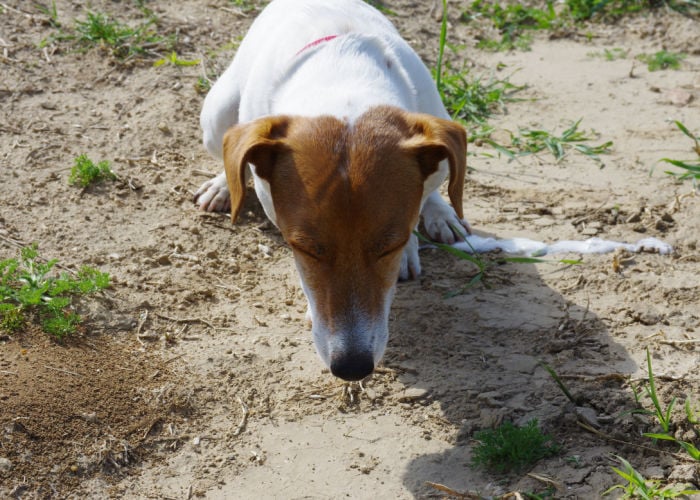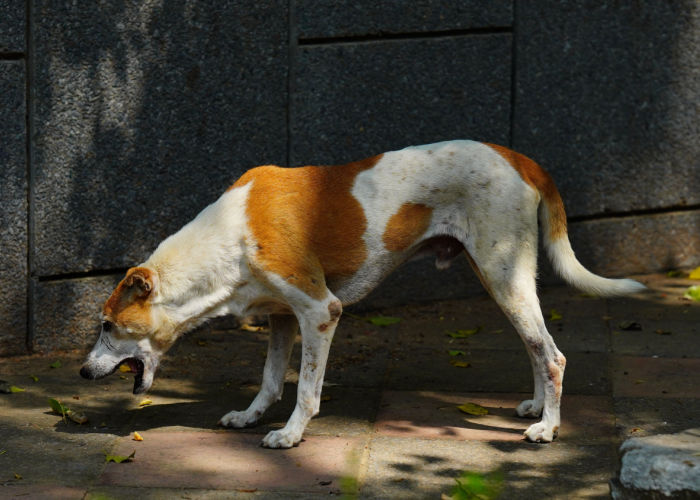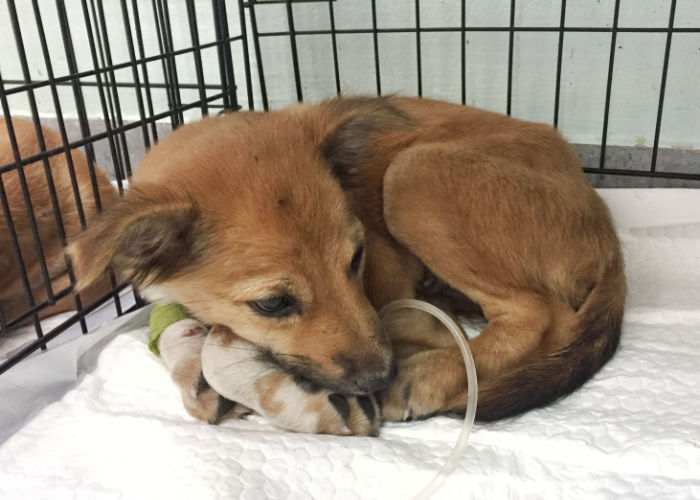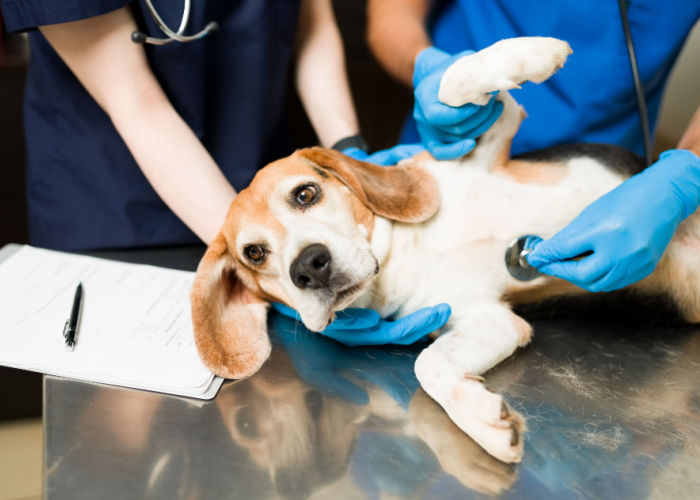Table of Contents
It is very alarming when we see our dog throwing up or we see vomit anywhere in our house. Below, we'll tackle everything you need about dog vomiting vet treatments.
Knowing about your dog's vomit can go a long way for pet owners. A dog's vomit can tell you something about your dog's health.
It's not rare for dogs to throw up every once in a while. Occasionally, a dog throwing up can be just because of overeating.
However, it can also be its way of getting rid of anything indigestible in its system, and some can be caused by an underlying health issue that can be fatal.
When your dog vomits, it can be worrisome and stressful for you and Fido. This blog will discuss the different kinds of treatments for dog vomiting.
But before getting into the treatment, you should know that there are different types of dog vomits.

Types of Dog Vomit
Different types of dog vomit can be identified by their appearance. It will differ in color, texture, and more.
- Yellow vomit – Common in dogs that have an empty stomach. The yellow color is caused by bile discharge.
- White vomit – A white vomit is usually foamy and caused by stomach acid buildup.
- Liquid vomit – Caused by stomach secretions or water pooling in the stomach.
- Mucous vomit – Slimy dog vomit is caused by excessive drooling and pools in the tummy in response to significant irritation.
- Bloody vomit – This vomiting can indicate serious conditions as it can mean internal bleeding.
- Green vomit – Can be caused by a contraction of the gall bladder before vomiting or by eating grass.
- Brown vomit – Dogs that vomit brown can indicate eating too fast. It can also be caused by accidentally eating poop.
When to Call a Vet about Dog Vomiting
When a dog vomits, it's best to withhold food (don't withhold water) for at least 12 hours.
If your dog doesn't vomit within that period and is acting normally, you can feed them small amounts of food in their next meal.
But if your dog starts to throw up mucus frequently, it's best to take them to the vet. Also, if your dog is young or old or has other health issues, consult your vet immediately.
If your dog vomits, it's important to take notes. These notes can be handy when it comes to diagnosis and treatment.
For instance, a few things that you should note are:
- If it's the first time he vomited
- When did your dog vomit
- The color of the vomit
- The number of times he vomits
- What the vomit looks like
- How much did he vomit
- Are there any indigestible materials in the vomit

Dog Vomiting Diagnosis
Once you're at the clinic, your vet will ask questions about your dog's vomit and overall health, so taking down the notes we've discussed above is helpful.
Using what you told them, they'll now choose and perform different tests to examine your dog. A few examples of these tests are:
- Blood tests
- Fecal tests
- Ultrasound
- Biopsy
- Radiographs
- Endoscopy
Dog Vomiting Vet Treatments
There are many possible causes of dog vomiting. It can be caused by a change in diet, or an underlying health problem can cause it.
The causes of dog vomiting will help us understand what kind of treatment your dog needs.
The treatment is connected to the diagnosis. And since there are many possible causes, plenty of possible treatments exist.
Medication for Nausea and Vomiting
Usually, the vet will administer an anti-nausea or an antacid medicine to help relieve the dog.
They can also prescribe other medications, such as antiemetics. And the most commonly used antiemetics is Cerenia, a drug that stops vomiting.
This drug will act as a trigger zone in the dog's brain to stop nausea. It also works on receptors in the tummy.
After the injection of Cerenia, it will be followed up with pills every 24 hours for a few days to ensure the vomiting is resolved.
Surgery
Dogs are curious creatures, and sometimes they'll ingest something they are not supposed to.
If the object gets stuck in the dog's body, it can cause vomiting and become an intestinal blockage.
In this type of vomiting, surgery is needed. Your vet will want to admit your dog into an animal hospital where they'll receive IV fluids to help them rehydrate.
Medication for nausea and pain will also be administered.
The surgery will be performed under anesthesia to help determine the blockage. If a foreign object causes the blockage, an incision is needed to be made into the intestines.
Once the thing is removed, the intestines will be sutured back up.
Fluid Therapy
Dehydration is the next outcome of nonstop vomiting. Vets will provide fluid therapy for a lot of reasons, including dehydration.
Fluid therapy replenishes a dog with sufficient liquids depleted due to trauma or other diseases.
It can be administered through the vein, under the skin, through the bone marrow, or the abdominal wall.
A Change in Diet
Vets will also suggest changing the diet for dogs recovering from vomiting. A bland diet is one of the most common ways to help your dog during these times.
A bland diet usually has white rice, sweet potato, boiled chicken, or white fish. Moreover, chicken broth is also high in nutritional value, which aids with dehydration.
Vets can also prescribe a special gastrointestinal diet together with some medication to help them feel relieved.
There are still plenty of home remedies that you can give to Fido if he's vomiting. You can try giving them ginger dog treats, probiotics, ice chips, and plain rice.

Frequently Asked Questions
Should I take my dog to the vet for vomiting?
If your dog vomits once or twice within 10 minutes and then acts normally, they are mostly fine.
However, if your dog vomits three or more times in eight hours, you should be worried and start calling your vet.
And if your dog is vomiting blood, take your dog to the vet immediately.
Should I give my dog water after vomiting?
If your dog vomits, it's best to withhold food for at least 12 hours. But don't withhold water.
Ensure they have access to water, but also avoid excessive water intake, which can lead to more vomiting.
Once the vomiting stops, you can give your pup small bland food meals and slowly increase the amount of water.
What is the most common cause of vomiting in dogs?
There are plenty of causes of vomiting in dogs. A few of the most common causes of vomiting in dogs are:
- Digestive system problems
- Kidney failure
- Liver failure
- Pancreatitis
- Nervous system disorders
- Overeating
- Bloat
- Parasites
- Infections
- Diet change
- Ingestion of poisonous substances
- Ingestion of foreign objects

Dog Vomiting Vet Treatments: Summary
Dog vomiting can cause immediate concern for us pet owners. We want to know what causes it and how to stop it from happening again.
The problem is that many things can cause vomiting in dogs.
It can be caused by as simple as overeating, but it can also be caused by serious health conditions such as pancreatitis.
That's why it's best to call your vet if your dog is experiencing other symptoms, together with vomiting.
We suggest consulting with your vet once when your dog has constantly been vomiting for a day.
Since there are a lot of possible causes, there are also many possible treatments for vomiting in dogs.
Determining the cause of a disease will help your vet specify the proper treatment needed for your pup.
There are plenty of dog vomiting vet treatments, including administering medications. These medicines will help soothe your dog's stomach and nausea.
Vets can also perform surgery if there's a blockage in the intestine. They can also provide fluid therapy for dehydrated dogs. And in some cases, a change in diet can be a good aid.













